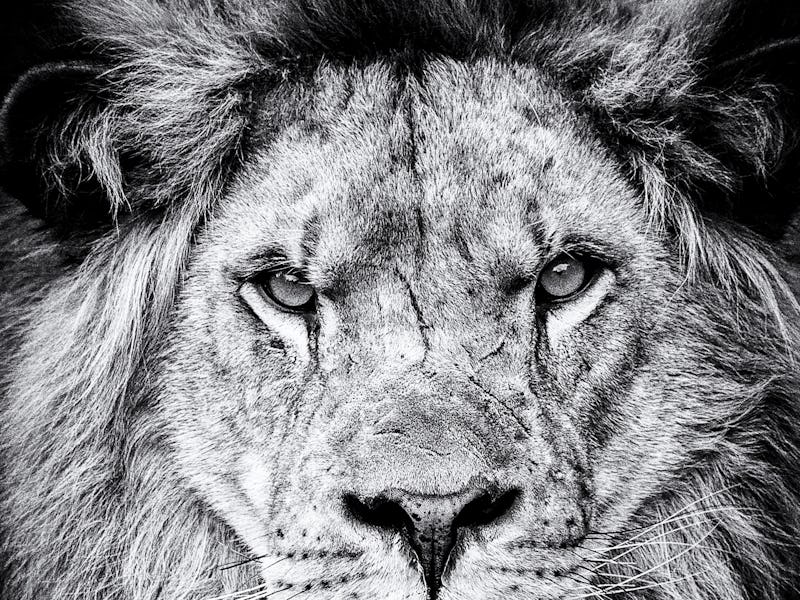Lion evolution study reveals a roadmap for big cat repopulation
The gene flow between two distinct groups answers some long-standing questions.

The real Lion Kings of Africa may be at the top of the food chain, but their populations are in trouble. Just 20,000 African lions remain in the wild: Over the last three decades, their numbers have plummeted by 40 percent, a drop propelled by habitat loss, illegal wildlife trade, and human conflict.
New research into the genetic links between different lion populations offers some hope for the vulnerable big cat. Researchers report that a new understanding of lion evolution may help scientists one day repopulate the parts of Africa where lion populations are most at risk.
Despite how much airtime lions get in our animated films and documentaries, scientists have known relatively little about the genetic history of Panthera leo. Now, a study published Monday in the journal Proceedings of the National Academy of Sciences provides a sweeping view of what's happened genetically to lions over the past half a million years.
Modern lions, which live today in both Africa and India, and extinct, ancient cave lions share an ancestor that lived 500,000 years ago, the study reports. This finding helps explain how genetic flow works across lion populations and could lead to better conservation practices, say the authors.
Researchers analyzed the genes of 20 lions from different groups, both living and extinct. These include:
- 6 modern lions from populations in Africa and India that are still alive today. Indian lions, also known as Asiatic lions, are slightly smaller than African lions.
- 12 extinct modern lions, from Africa and the Middle East, which lived between the 1600s and 1959
- 2 extinct cave lions, from Siberia and the Yukon, which lived around 30,000 years ago
All three of the groups of lions had a common ancestor that lived half a million years ago, long before the modern lions diverged from the cave lions, the analysis shows.
In turn, the lion genes show that after that divergence there was no hybridization between cave and modern lions — which is potentially bad news for anyone hoping for a cave lion comeback.
An Asiatic lion in an enclosure at the Kamla Nehru Zoological Garden in western India.
As for the two modern species – today's lions and the population that went extinct in the mid-20th century — they likely split off from one another around 70,000 years ago.
But it wasn't goodby forever: The scientists found that gene flow, or transfer of genes between populations, continued between the two groups even after they split.
Today, as a result, West African lions are the closest living relatives to the extinct group in North Africa. This contradicts the theory that lions living in India are the closes relatives to the extinct North African lions.
That matters because previously it was assumed that, if scientists were to reintroduce lions to North Africa, they would want to bring in the lions from India to restore the extinct populations.
It's "fascinating to learn more about how they spread to be once one of the most widely distributed and successful large mammal predators," coauthor Tom Gilbert, a researcher at the University of Copenhagen, tells Inverse.
"Lions are in trouble today," Gilbert says. "The more we learn about them, the more information we [the conservation community] will have at our fingertips to help preserve them."
Indian lions have minimal genetic diversity — The genetic analysis of lions from India showed that the small population has very low genetic diversity, in part because of its tiny size.
Other research, on ancient remains of woolly mammoths, shows that tiny populations and low diversity may spell trouble for a declining species. When mighty mammoths were nearing their end, they suffered from several genetic problems resulting from inbreeding; when you're down to your last remaining members, it's tough to branch out genetically.
In the case of lions, humans are driving those smaller population numbers.
By looking at the data, "we can see just how big the impact is on their genetic diversity of recent human pressure," Gilbert says. He describes it as a "scarily big impact."
The researchers hope that having a better understanding of lion genes can help to better protect the big cats.
Gilbert says the data "provides information that could be used to make informed decisions should researchers want to start moving lions around to bolster very troubled populations or even replenish now extinct ones."
Abstract: Lions are one of the world’s most iconic megafauna, yet little is known about their temporal and spatial demographic history and population differentiation. We analyzed a genomic dataset of 20 specimens: two ca. 30,000-y-old cave lions (Panthera leo spelaea), 12 historic lions (Panthera leo leo/Panthera leo melanochaita) that lived between the 15th and 20th centuries outside the current geographic distribution of lions, and 6 present-day lions from Africa and India. We found that cave and modern lions shared an ancestor ca. 500,000 y ago and that the 2 lineages likely did not hybridize following their divergence. Within modern lions, we found 2 main lineages that diverged ca. 70,000 y ago, with clear evidence of subsequent gene flow. Our data also reveal a nearly complete absence of genetic diversity within Indian lions, probably due to well-documented extremely low effective population sizes in the recent past. Our results contribute toward the understanding of the evolutionary history of lions and complement conservation efforts to protect the diversity of this vulnerable species.